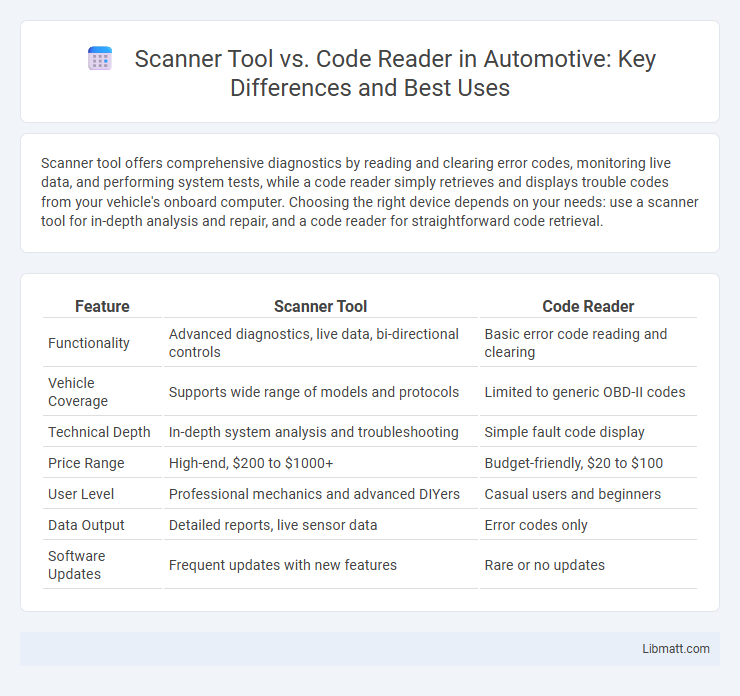Scanner tool offers comprehensive diagnostics by reading and clearing error codes, monitoring live data, and performing system tests, while a code reader simply retrieves and displays trouble codes from your vehicle's onboard computer. Choosing the right device depends on your needs: use a scanner tool for in-depth analysis and repair, and a code reader for straightforward code retrieval.
Table of Comparison
| Feature | Scanner Tool | Code Reader |
|---|---|---|
| Functionality | Advanced diagnostics, live data, bi-directional controls | Basic error code reading and clearing |
| Vehicle Coverage | Supports wide range of models and protocols | Limited to generic OBD-II codes |
| Technical Depth | In-depth system analysis and troubleshooting | Simple fault code display |
| Price Range | High-end, $200 to $1000+ | Budget-friendly, $20 to $100 |
| User Level | Professional mechanics and advanced DIYers | Casual users and beginners |
| Data Output | Detailed reports, live sensor data | Error codes only |
| Software Updates | Frequent updates with new features | Rare or no updates |
Introduction: Scanner Tool vs Code Reader
A Scanner Tool offers comprehensive diagnostics by accessing live data, performing system tests, and reading trouble codes in real-time, making it ideal for in-depth vehicle analysis. Code Readers primarily focus on retrieving and clearing diagnostic trouble codes (DTCs), providing a basic overview of engine and system issues without advanced testing functions. Understanding the capabilities of each device helps you choose the right tool for precise vehicle diagnostics and efficient maintenance.
Understanding Scanner Tools
Scanner tools provide comprehensive diagnostics by accessing real-time data, reading trouble codes, and offering detailed live performance metrics from a vehicle's onboard computer systems. Unlike basic code readers, scanner tools support enhanced functionalities such as bi-directional control, advanced troubleshooting, and the ability to reset various system warnings. These capabilities enable mechanics and technicians to perform in-depth analysis and efficient repairs, ensuring accurate vehicle diagnostics.
Understanding Code Readers
Code readers are essential diagnostic devices designed to interpret and display error codes from a vehicle's onboard computer system, primarily focusing on reading and clearing generic trouble codes. Unlike advanced scanner tools, code readers offer limited functionality by providing basic code retrieval without extensive data visualization or live sensor monitoring. Their compact design and user-friendly interface make them ideal for quick diagnostics and straightforward vehicle maintenance tasks.
Key Differences Between Scanner Tools and Code Readers
Scanner tools provide comprehensive diagnostics by accessing multiple vehicle systems, enabling live data streaming, advanced troubleshooting, and active testing, whereas code readers primarily retrieve and clear basic diagnostic trouble codes (DTCs) from the engine control unit (ECU). Scanner tools often support complex functions like ABS, SRS, and transmission diagnostics, offering deeper insight for professional mechanics, while code readers are designed for quick, user-friendly fault code identification primarily targeting engine issues. The enhanced capabilities of scanner tools make them suitable for detailed vehicle analysis, whereas code readers are ideal for routine maintenance and simple code clearing.
Features Comparison: Scanner Tool vs Code Reader
Scanner tools offer comprehensive diagnostics by accessing live data, reading trouble codes, and providing real-time sensor information, while code readers primarily retrieve and clear basic trouble codes. Scanner tools support advanced functionalities such as system tests, coding, and bi-directional controls, whereas code readers are limited to code reading and resetting functions. The enhanced data display and interactive features make scanner tools ideal for professional mechanics, contrasting with code readers designed for basic troubleshooting by everyday vehicle owners.
Ease of Use: Scanner Tools vs Code Readers
Scanner tools offer greater ease of use with intuitive interfaces and automated diagnostics, making them ideal for both beginners and professionals. Code readers tend to be more basic, often requiring manual navigation through error codes, which can be less user-friendly. Your experience will improve significantly with a scanner tool designed to provide detailed data and step-by-step troubleshooting guidance.
Compatibility and Vehicle Coverage
Scanner tools offer broader compatibility and extensive vehicle coverage, supporting a wide range of makes and models from various manufacturers, including domestic, European, and Asian brands. Code readers generally have limited compatibility, often tailored to specific vehicle types or manufacturers, restricting their usefulness for diagnosing multiple car brands. Advanced scanner tools frequently update their databases to include new vehicle systems and protocols, ensuring ongoing compatibility and comprehensive diagnostics.
Price and Value Analysis
Scanner tools generally offer higher prices compared to code readers due to their advanced diagnostics and broader vehicle compatibility, delivering greater overall value for professional mechanics. Code readers are typically more affordable, providing basic error code retrieval suited for casual users or DIY enthusiasts who require cost-effective, straightforward tools. Investing in a scanner tool yields long-term savings by identifying complex issues early, potentially avoiding expensive repairs and enhancing vehicle maintenance efficiency.
Pros and Cons of Scanner Tools and Code Readers
Scanner tools offer comprehensive diagnostics by providing detailed fault codes, live data, and advanced features like ECU programming, but they tend to be more expensive and complex to operate. Code readers are cost-effective and user-friendly for basic code retrieval and clearing, yet they lack extensive functionalities and depth in diagnostics. Choosing between the two depends on the user's expertise and the level of vehicle troubleshooting required.
Choosing the Right Device for Your Needs
Choosing the right device depends on your diagnostic requirements and technical expertise. A scanner tool offers comprehensive vehicle diagnostics, live data streaming, and advanced features ideal for mechanics or serious DIYers, while a code reader provides basic error code retrieval suitable for quick, simple checks. Your choice should align with how extensively you want to troubleshoot and maintain your vehicle.
Scanner Tool vs Code Reader Infographic

 libmatt.com
libmatt.com